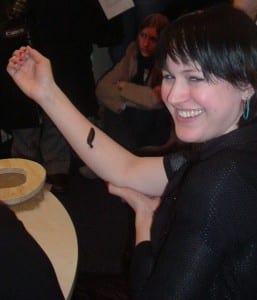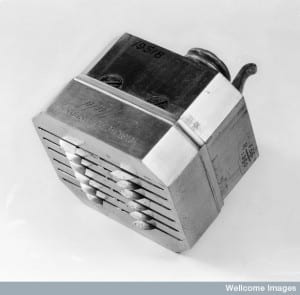Leeches! Leeches!! Leeches!!!
By Gemma Angel, on 9 July 2012
 by Sarah Chaney
by Sarah Chaney
So ran one particularly enthusiastic nineteenth century advertisement for the animal that has had the most enduring association with medical history. So much so, that one inspired individual decided to make a mechanical version of the creature. During my public engagement sessions in the Grant Museum, I’ve tried asking various visitors to guess what animal the fist-sized metal box was designed to emulate: no one has yet hit on the right answer, even though I usually stand right in front of the leech cabinet. Shiny, clean and angular, where the leech is squat, wet and slug-like, there would appear to be little comparison between the two.
Indeed, that was the claim of certain nineteenth century leech advocates, who deemed the miraculous little creature itself far gentler than lancet, fleam or scarifier (also called a scarificator: the “mechanical leech” in the illustration, left). The leech secretes a substance called hirudin, which stops the blood from clotting, meaning that one small bite will continue to bleed for around 12 hours after the leech has been removed. I know this well, for, in the pursuit of medical history, I have been leeched not once, but twice, and still have the (tiny) scars to prove it!
Testing out ancient cures is an intriguing – but by no means recommended – practice. For myself, it gave me a far greater appreciation of the unique abilities of a creature that had previously seemed to me only a particularly ugly vampire. The movements of leeches are surprisingly elegant – they stretch out, entwine around each other, and swim rapidly with a characteristic s-shaped wiggle. They create very little trauma when they bite and, although the process is lengthy (I never in my wildest imaginings thought it would take as long as an hour and a half for the leech to drink its fill, but it did), it isn’t as unpleasant as might be expected. It’s easy to see why the leech might have been a more popular choice in the widely prescribed practice of bloodletting than its viciously-bladed mechanical twin. And bloodletting had, since ancient times, been adopted for an extremely broad variety of ailments: and even as a regular “tonic” (to be carried out in the spring) to ensure continued good health.
 Since the scarifier did not have the leech’s hirudin to prolong the bleeding, it required rather a lot more (and larger) blades than the leech’s tri-radiate jaws. To use it, you would turn the lever to ready the spring mechanism, place on the skin, and press the switch to release. The blades whip round with a satisfying click, leaving twelve shallow wounds. Of course, you’d then need a bleeding bowl to measure the amount of blood lost. This is not necessary with live leeches, which effectively have a built in mechanism for this; one leech generally takes one ounce (about 30ml) of blood. What’s more, the leech tidily disposes of the blood removed, efficiently recycling it to fuel its own existence.
Since the scarifier did not have the leech’s hirudin to prolong the bleeding, it required rather a lot more (and larger) blades than the leech’s tri-radiate jaws. To use it, you would turn the lever to ready the spring mechanism, place on the skin, and press the switch to release. The blades whip round with a satisfying click, leaving twelve shallow wounds. Of course, you’d then need a bleeding bowl to measure the amount of blood lost. This is not necessary with live leeches, which effectively have a built in mechanism for this; one leech generally takes one ounce (about 30ml) of blood. What’s more, the leech tidily disposes of the blood removed, efficiently recycling it to fuel its own existence.
Despite efforts to emulate it, or extract its natural hirudin, the leech has not been improved upon by science. Leeches themselves are thus still used in clinical practice today, particularly in reconstructive and cosmetic procedures. The scarifier, meanwhile, is now only a curious reminder of an era obsessed with mechanism: much as our own is obsessed with computer-based technology.
 Close
Close



